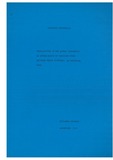| dc.description.abstract | The testing of various explanations of international trade patterns always arouses a good share of academic interest. Unfortunately, due to imperfections embodied in the testing processes and due to imperfect data, the results can only offer additional insight into the hypothesis being tested but cannot prove or disprove a specific theory.
In the context of international trade empirical tests have mainly centered around the Ricardian 1abor productivity hypothesis and the Heckscher-Ohlin explanation with the related Leontief paradox. However, in 1961 S. B. Linder presented an alternative explanation. While accepting the Heckscher-Oh1in explanation for trade in agricultural
products and raw materials, Linder did not consider it rigorous enough to explain trade for more sophisticated manufactured goods. According to Linder, all manufactured goods are potential exports, but in order to become an actual export there must exist a domestic demand for the product. In other words. it is demand, not supply,
which determines the patterns of trade. Linder goes further and claims that the more similar the demand
preferences, or tastes, of two countries, the higher the volume of their bilateral trade. Moreover, similarities in preferences can be associated with similar levels of income. This thesis has been tested by Linder through an informal but demonstrating testl and others with more or less substantiating results. Most concluded that the Linder postulation offered a complementary explanation for trade. Sailor, Queresh, and Cross, using a Spearman rho criterion found nine countries in which the rank order correlation coefficient as significant at the 5% level, eighth at the 1% level,
and fourteen countries with no significant correlation. However, Hoftuzer· criticized them for not including the distance variable which he considered the only really significant explanatory variable. In another study Fortune runs a multi-regression model and finds differences in per capita income important for seven out of twentythree
countries and the distance variable important in seventeen out of twenty-three cases. Although it is obvious that a full test of the Linder tnesis would require evidence from many countries, the more the better, my intention is to test it only with respect to Canada in order to see if it can offer any additional insight into Canadian trading patterns. | en_UK |


